
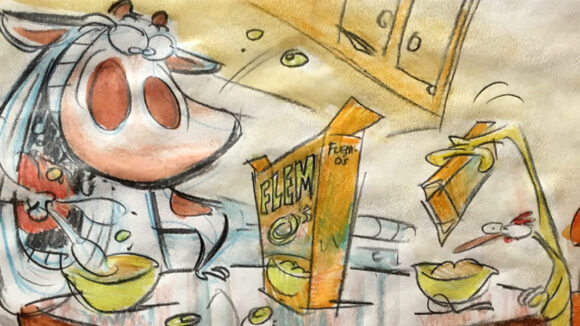
25 Years Of ‘Cow & Chicken’: A Conversation With Creator David Feiss
Cow and Chicken, the beloved ’90s animated series that followed the amusingly bizarre mishaps of two unlikely siblings living in the human world, was among the earliest original Cartoon Network productions. The show, which premiered on July 15, 1997 and spawned four seasons, turns 25 years old this week.
For creator David Feiss, who was already a seasoned industry artist prior to creating the series, Cow and Chicken presented the rare opportunity to use his personal cartooning style and comedic sensibilities, which often prioritized wackiness over logic. The brother-and-sister dynamic between the naïve Cow and the grumpy Chicken grounded the absurdism of the concept, which includes a demon-like figure, the Red Guy, as its antagonist. As part of the series, Feiss also created I Am Weasel, a separate idea about an unexpected hero that later spun off into its own series.
On the occasion of the show’s anniversary, Cartoon Brew spoke with Feiss about the spontaneous origins of Cow and Chicken, his memories of those early Cartoon Network days, and why he’d prefer to reboot the characters in cgi. The interview is illustrated with early Cow & Chicken development artwork by Feiss.
Cartoon Brew: Where did you first conceive of the idea for “Cow and Chicken”? I’m fascinated by how singularly unconventional the show was in its time.
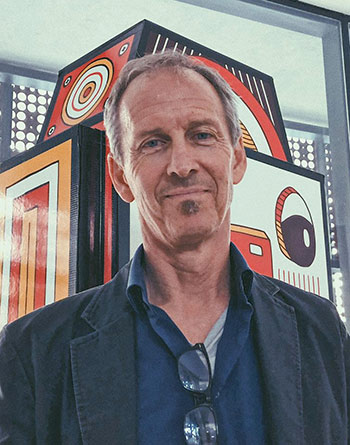
David Feiss: It started with a bedtime story I told my daughter who was six at the time. I used to read her bedtime stories and one night, for whatever reason, I was too tired to read, but I just made up a story of Cow and Chicken. She liked it and the next morning I remembered it, so I drew it out in a 25-page children’s book and that was the beginning. I have the original story book that I drew out. Within a few weeks, I got a call from Hanna-Barbera saying that this new network, Cartoon Network, was looking for new ideas. They had a slate of 52 shorts they wanted to do. I went and I pitched some ideas, including Cow and Chicken, and that was the one they liked. Soon, I was working on the concept for a storyboard [that would become] the pilot. I changed it a bit from the story that I had told my daughter, kept the title, kept the basic dynamic, and then at some point added the Red Guy.
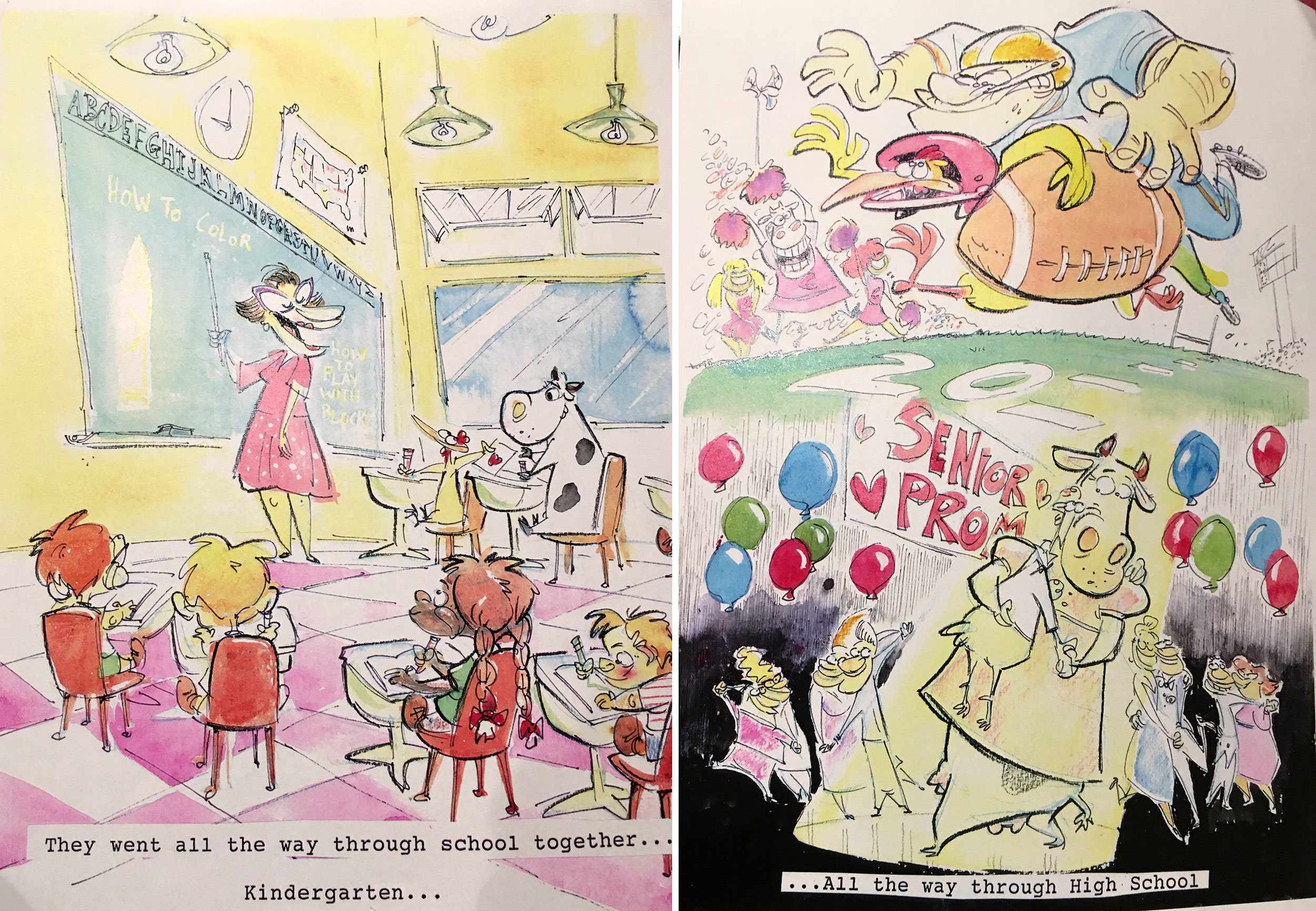
How did the concept evolve from that first iteration to what you delivered from the pilot?
Feiss: At first, I didn’t have them as brother and sister. The concept was that they were friends, they went to school together, and they grew up together. Then they went apart, and they came back together at the end. But when I started coming up with an idea for a pilot, I realized I needed a little bit more drama than that. A little bit more silliness. And that’s when I changed the dynamic, made them have parents that you only see their legs. And then I added the Red Guy, which to me was the key to the whole thing, adding that extra element of chaos.
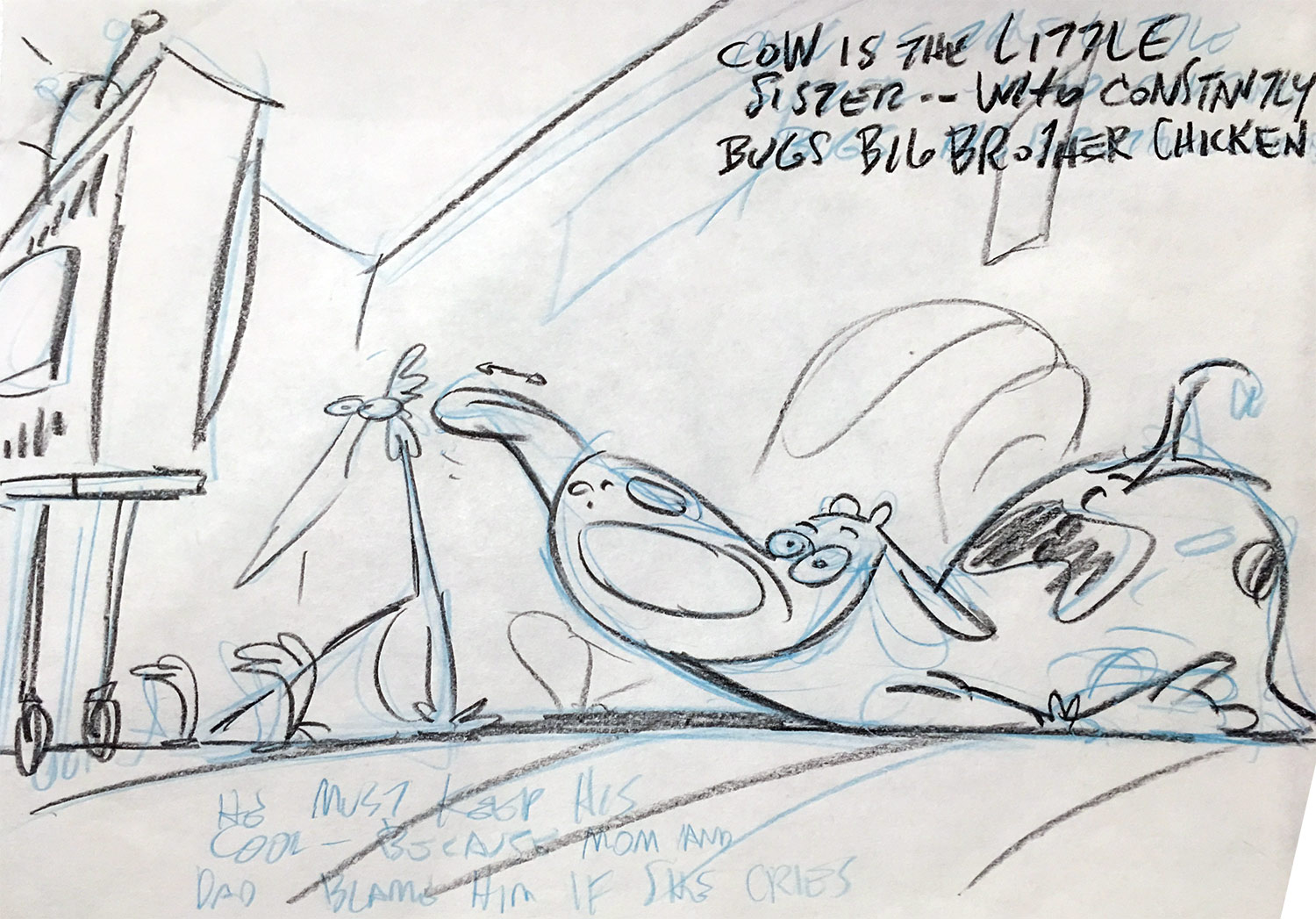
Since the Red Guy wasn’t part of the original bedtime tale, where did he come from and was there any pushback about having a depiction of the devil in a show for kids?
Feiss: When they said we want to do a Cow and Chicken pilot, and I started writing it and drawing it, I realized I needed something else. I had a dream about the Red Guy. I dreamed of this little red character, and I used a line for my dream in the pilot where he says, “Hello, it’s me, the devil, I stand for all that is bad, also I’m naked.” That was in my dream. I woke up and I drew it out in storyboard panels, so I would remember it. The next day, I incorporated it into my story. For the pilot he was known as the Devil, but once it got green lit as a tv series, I was told you can’t call him the devil, which was better because it was more fun just to have him as a generic Red Guy who also had names that were silly pertaining to the fact he had no pants on.
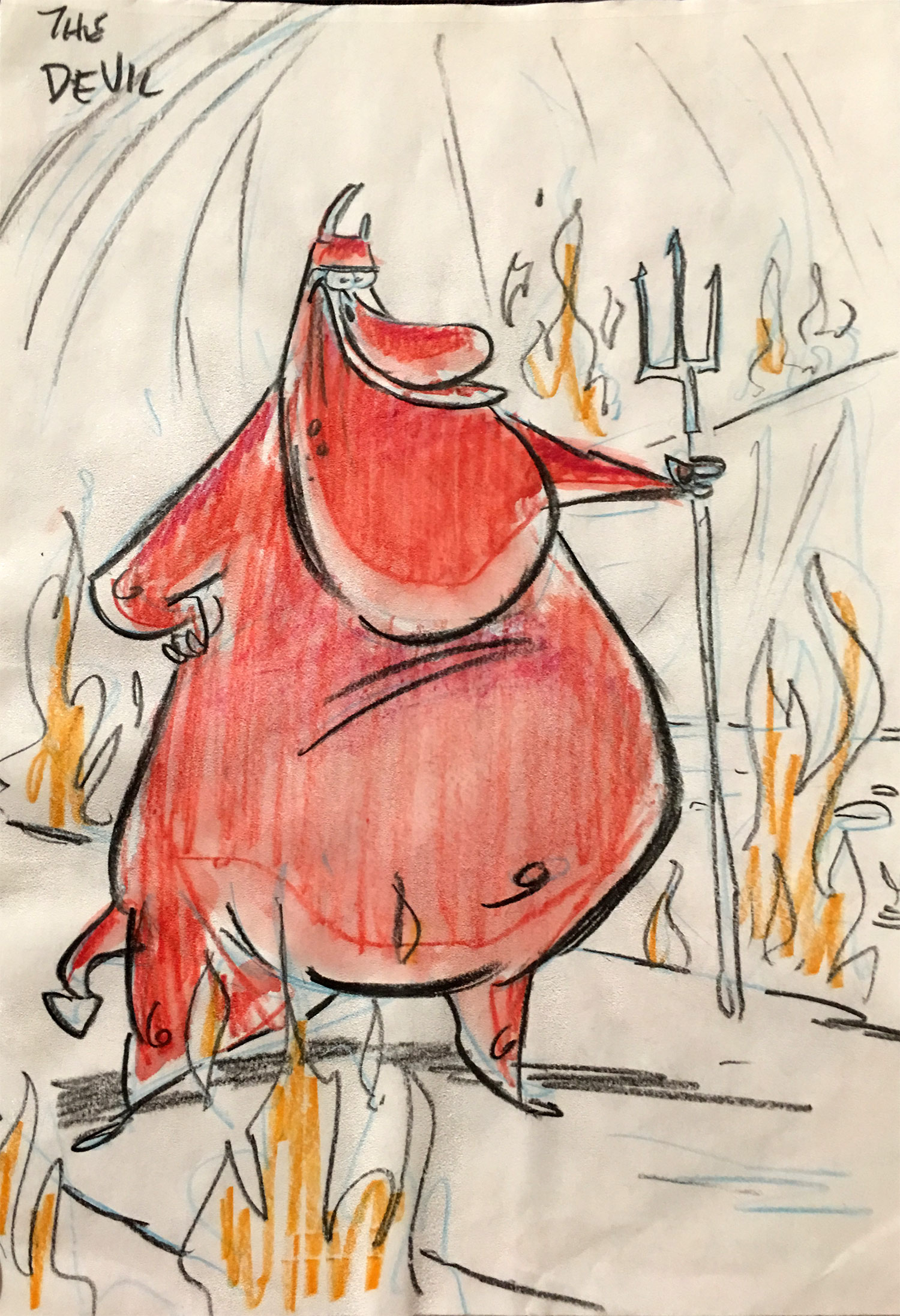
I’m glad that there was no further pushback beyond that.
Feiss: Exactly. He was my favorite character because of how abstract he was.
You had worked in animation for a long time before Cow and Chicken came around. Do you feel that the style of animation in this show was something that you were suppressing as you worked on other people’s projects?
Feiss: That’s exactly right. I’d basically had a sillier style through my teen years, and it was a struggle. I started working in animation at Hanna-Barbera at age 19, and I was learning to draw. I’d done animation as a kid – I made an 8mm film – and that’s how I got hired at Hanna Barbera, but it was a struggle to try to draw Fred Flintstone or Scooby-Doo. Those are tough. But for the most part, since Cow and Chicken I’ve been allowed to basically do my style, even in other films that I’ve worked on. I’ve mostly done storyboards for the last 20 years and I do my own style. It’s easier to do your own style as a storyboarder as opposed to do your own style as an animator. As an animator, your drawing is getting up on the screen and if you’re drawing in your own style and it’s different than the style of the show, that’s an issue.
Did the conception of the I Am Weasel segments happen at the same time?
Feiss: I did the pilot of Cow and Chicken, we tested it, and they said, ‘We want to do a series.’ But then they said, “We want do a half -hour format with two seven-minute Cow and Chickens and we want a new middle cartoon that’s different than Cow and Chicken.” They asked if I had any ideas. The title I Am Weasel came from the title of one of my favorite books growing up by a writer named Richard Matheson. He wrote, I Am Legend, which later became a Will Smith movie. I thought of this character who instead of being the classic weasel character, being sneaky and bad, was heroic. He’s still a weasel, but everybody loves him. And because of the dynamic of the song, “Pop Goes the Weasel,” about a monkey and a weasel, I wrote the monkey as the anti-weasel. I made the monkey insanely jealous. Plus, I made him a baboon, which I thought was even funnier than just a monkey because of the red butt, which kids always laugh about at the zoo. My kids would laugh at the butt on the baboon. We did the middle cartoon on the weasel during three seasons of Cow Chicken and then it spun off into its own half-hour series with three episodes per shows.
Seems like Cartoon Network was open to almost anything back in those days…
Feiss: They were. It felt that way. They were a new network, and they were just trying to get noticed and wanted things that were different and fresh.
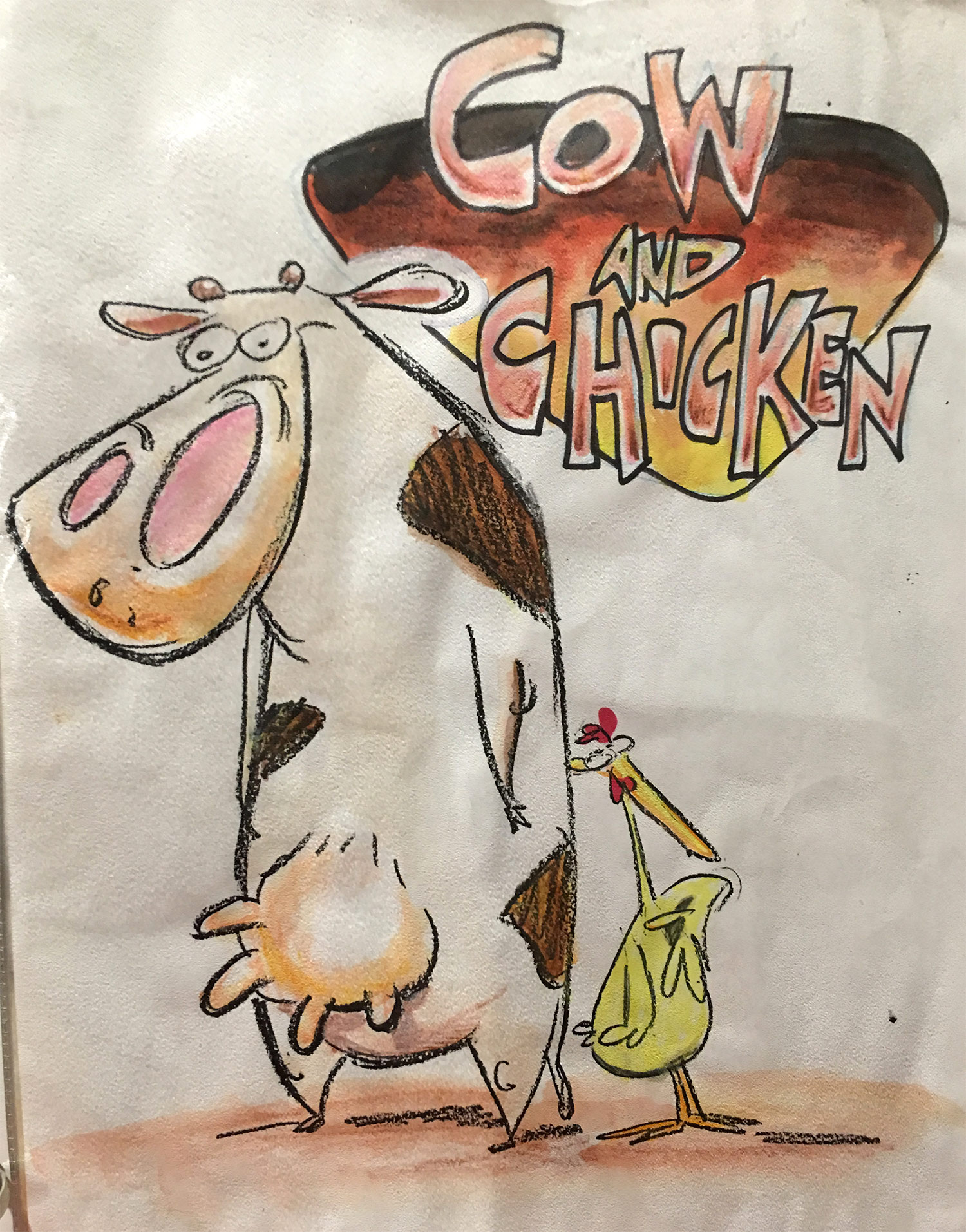
In addition to the sibling dynamic that fuels the show, there’s also the hilariously heroic figure of Super Cow. Was this idea in the storybook or did it come later?
Feiss: That was another instant idea I had when doing the story for the pilot. I thoughts, ‘Maybe this innocent cow has this alter ego, and she only speaks Spanish when she’s this superhero.’ It just felt sillier. She could fly as Super Cow, but normally she can’t fly and nobody else knows who her true identity is, but Chicken does. In fact, in the pilot, he gets captured by the Devil and brought down to hell and he calls his sister to help him. She goes, ‘I can’t help you,’ and he says, ‘Send Super Cow.’ Then she gets the idea and comes back dressed like this superhero and flies down to hell and rescues her brother.
All these characters are voiced by the same actor, Charlie Adler. How did you meet him? Was he perhaps already working on other shows at Cartoon Network?
Feiss: I don’t think he was working on other shows at Cartoon Network at that time. Probably the last thing he had done was Tiny Toons. He was Buster Bunny. But I had never met him before. When I did the Cow and Chicken pilot, I held auditions. They brought in a lot of people, maybe a hundred people to audition for all the different parts. Charlie Adler came in and auditioned for Cow, then he auditioned for Chicken, and then he auditioned for the Red Guy. After all was said and done, he was the best at all those characters. There was a little pushback from Cartoon Network. They thought, ‘You need to have different people play different characters.’ I said, ‘No, think of Mel Blanc. He did all the voices. This guy is the best.’ Everybody agreed. The funny thing about Charlie Adler is that he does those characters in order. He can have Cow talk to Chicken back and forth, and then the Red Guy will interject. He doesn’t have to prepare for it. He just bursts into it. He separates those characters so clearly in his mind. He also plays the baboon and the weasel is Michael Dorn from Star Trek: The Next Generation.
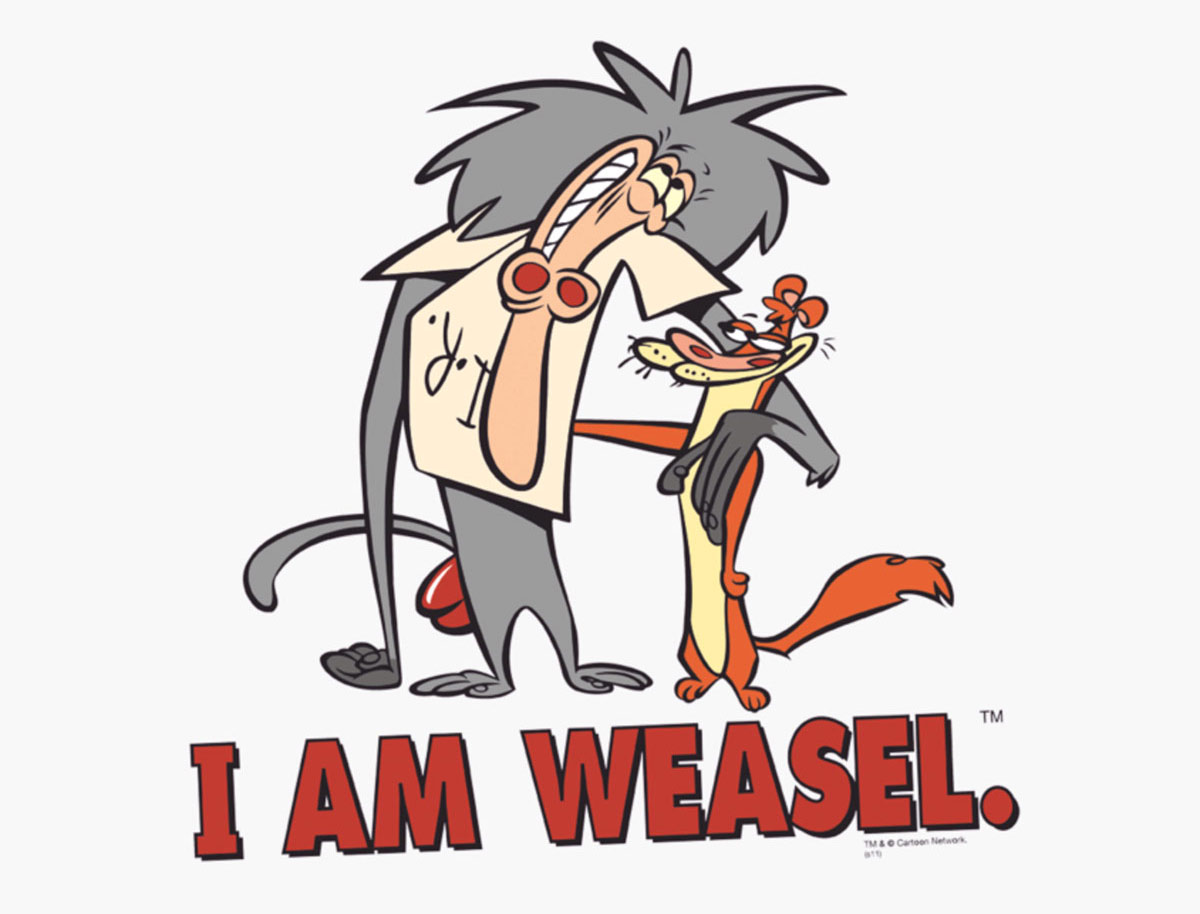
Was there a reason why you wanted two different actors for the protagonists in I Am Weasel?
Feiss: For the weasel character I was thinking of a very large booming voice. My first thought was James Earl Jones, who was the voice of CNN at the time and Darth Vader. But Michael Dorn was recommended to me by Van Partible, who created another of the three original Cartoon Network shows, Johnny Bravo, and [who’s] a good friend of mine. And I thought, ‘My goodness, this voice is perfect.’ Michael came in and he got the joke. He loved doing Weasel and we did 79 episodes with him as Weasel.
When the show ended in 1999, did you feel it had run its course or did you want to do more Cow and Chicken episodes?
Feiss: I wanted to do more. I guess they felt like it was time to move on to other ideas. But I definitely still have more ideas for Cow, Chicken, and Weasel. I always was hoping that at some point that they would ask for more. But, as of yet, they’ve not.
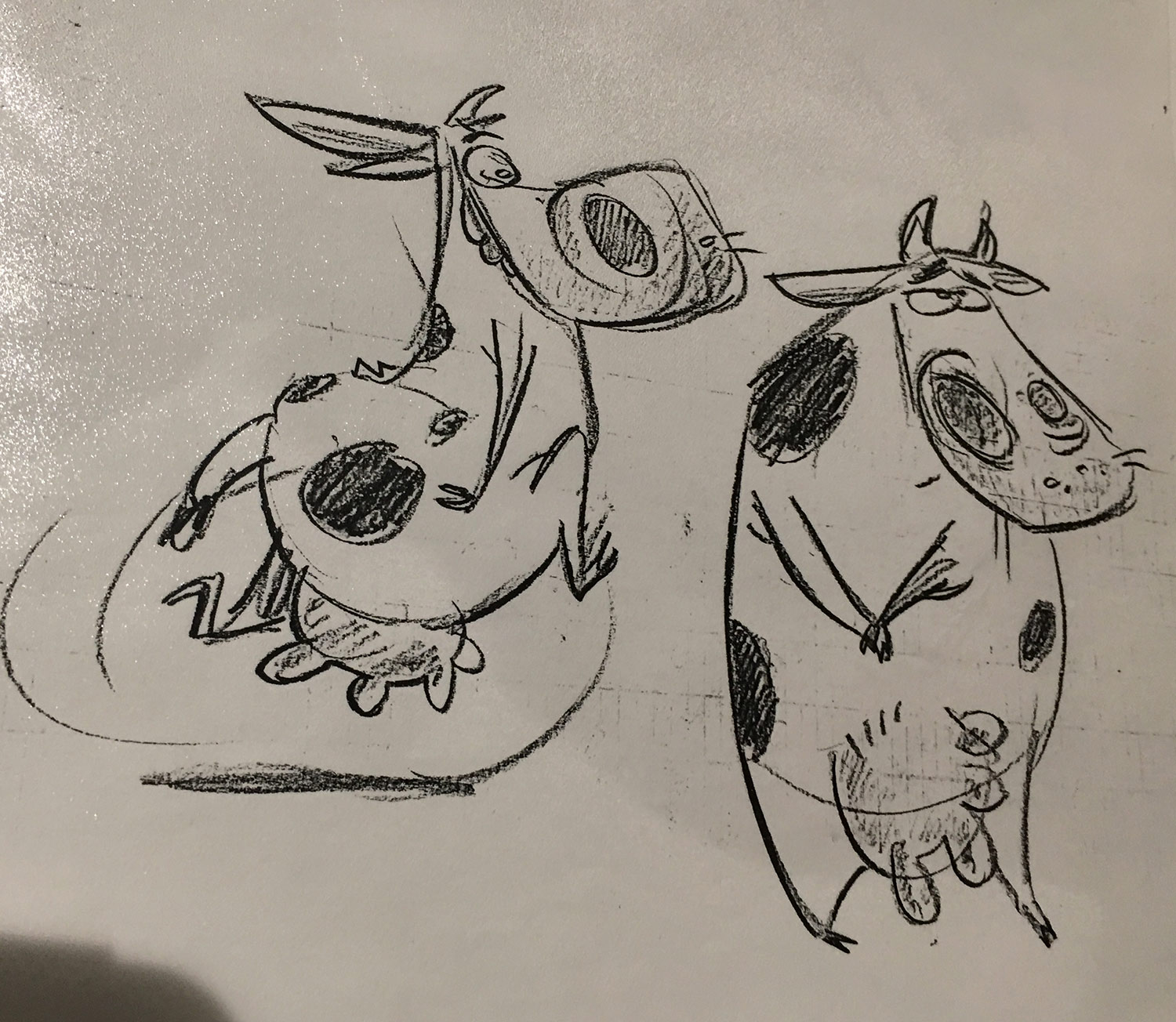
Do you feel the show, with all its wonderful strangeness, could be made today?
Feiss: I think it could. There are other films and shows out there that are even more abstract now. If it was made today, I would probably do it in cg, actually. I’ve been working in cg quite a bit. I directed a film over at Sony, Open Season: Scared Silly, where I designed the characters that were done in cg and my character design seems to translate just fine. I would love to do Cow and Chicken in cg.
Describe the process of creating the episodes with your crew from idea to execution?
Feiss: I had a team of writers, but there was one writer in particular, Mike Ryan, who was my story editor. He and I would get together every week and we’d go over ideas. The scripts for Cow and Chicken weren’t long scripts. They were two-page outlines, and it was up to the board artist to flesh it out. That’s how the process worked. Then the boards would come to me, and I would add panels or remove or whatever before recording. We then recorded from the storyboard. That was our real script.
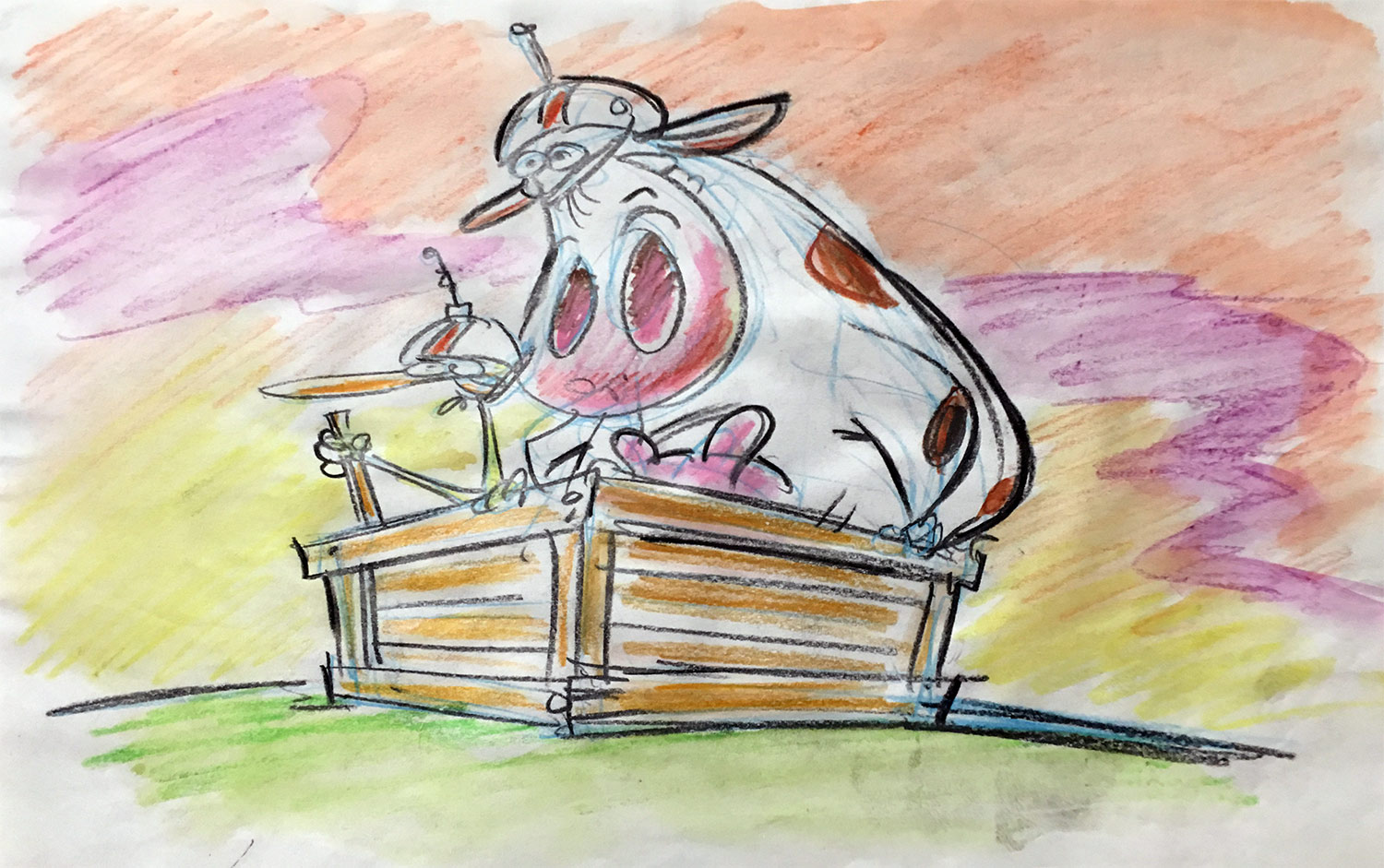
Were you ever tempted to show or create the faces or full bodies of Cow and Chicken’s parents?
Feiss: No. It’s funny, to this day people ask, ‘What do they look like?’ There was one episode where there was a science project in the closet that Chicken or Cow pulls out and it shows the top parts of people with no legs. They are rifling through the closet, and they see this, ‘Oh yeah, it’s that old science project.’ That was possibly what they would’ve looked like. But for the most part, they were just supposed to be legs. That was the joke that I put in from when I grew up watching Tom and Jerry where for some characters you’d only see their legs or even Charlie Brown with the muffled voice [of the adults]. The animation of the forties would have just legs. I thought it would be funny if they were just legs. In the pilot, in the very last shot, you pull out and see that they’re just legs. They have no tops. But then later in the series, I never showed the top again. It was always just the legs. You would see them doing things with their feet, like pouring orange juice or writing a letter with their feet.
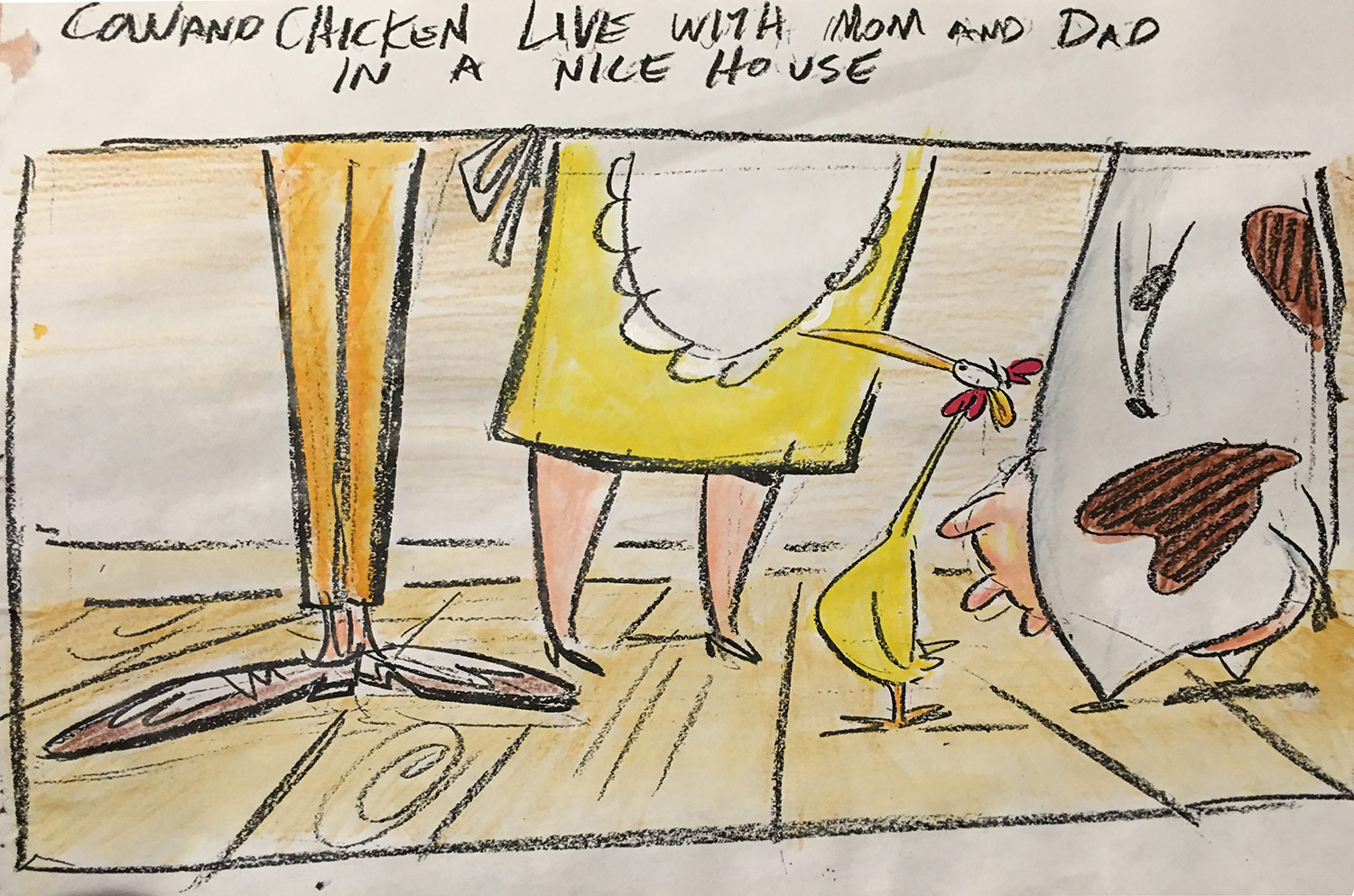
As you were developing this show, were you in contact with any of the other animators making their own Cartoon Network projects or were you working in isolation?
Feiss: It was for the most part in isolation, but I was living in Sacramento at the time. I was raising my kids up there, so I would commute down to L.A. two days a week. But I became friends with Van [Partible] and Genndy [Tartakovsky]. I didn’t know Craig McCracken as well, but I knew him. Genndy, Van, and I had the first three Cartoon Network series [commissions from What A Cartoon! pilot program]. They did press interviews with all three of us together. Then during production, I would see what they were doing. Genndy actually ended up doing a storyboard on Cow and Chicken. I see Van from time to time. It was a unique time at the studio.
What would you say made those early days at Cartoon Network and the first group of shows special?
Feiss: For me personally, I’d been in the industry for 15 years as an animator. I’d been almost exclusively animating. This was the first opportunity to do my own thing. That was great. I was coming up with stories and drawing on ideas from my youth, things that I did as a kid and things my kids had done and things that I’ve observed in the news. It was a real creative time, just constantly thinking of ideas. I lived in Sacramento, I would fly back and forth. I would have time on the flight to write and I wrote a lot. It was a real vital period. The other guys, both Genndy and Van are about 10 years younger than me. They were about 25 years old. Genndy had just gotten out of Calarts and Van from LMU [Loyola Marymount University]. Here were these young people in this situation, but they got run their own tv series. It was pretty vital and exciting for them too.
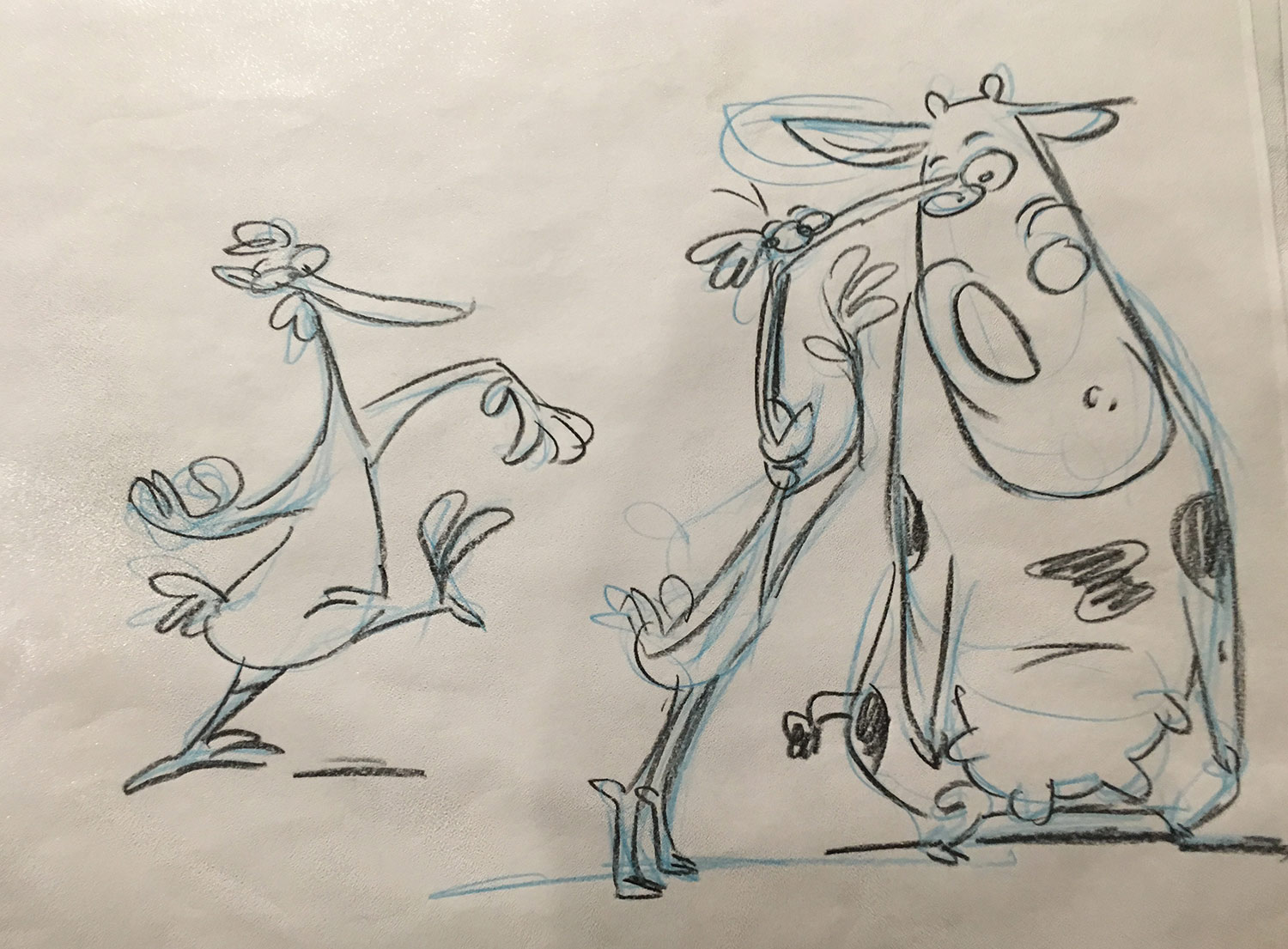
Did you have an idea for a Cow and Chicken movie? In terms of theatrical feature films, Cartoon Network only ever made The Powerpuff Girls Movie and that didn’t do well. I wondered if you ever thought about a movie idea for your characters.
Feiss: Yes. When the series was coming to an end, Cartoon Network did say, ‘If we wanted to do a movie, do you have an idea for that?’ Mike Ryan and I did come up with an idea. But I don’t remember what it was about. It might have been about them traveling and looking for something. I don’t remember exactly now. We had an outline for the film, but it never went farther than that.
Twenty-five years on, I hope that you feel that this show is still remembered. Do you see the appreciation for Cow and Chicken when you attend conventions or animation events?
Feiss: People in the United States know the show, but it seemed to be bigger in Latin America and in Europe. I was in Italy a few years back and I had a lot of Italian kids that just so fondly remembered it. I went to an animation conference in Mexico, and it was the same thing. People would get emotional about it, [telling me,] ‘It was part of my childhood.’ It was a great feeling. I felt really honored and I did a lot of drawings for everybody, especially in Chile. I remember there was a line of a few hundred people. I spent about four hours doing drawings for them.
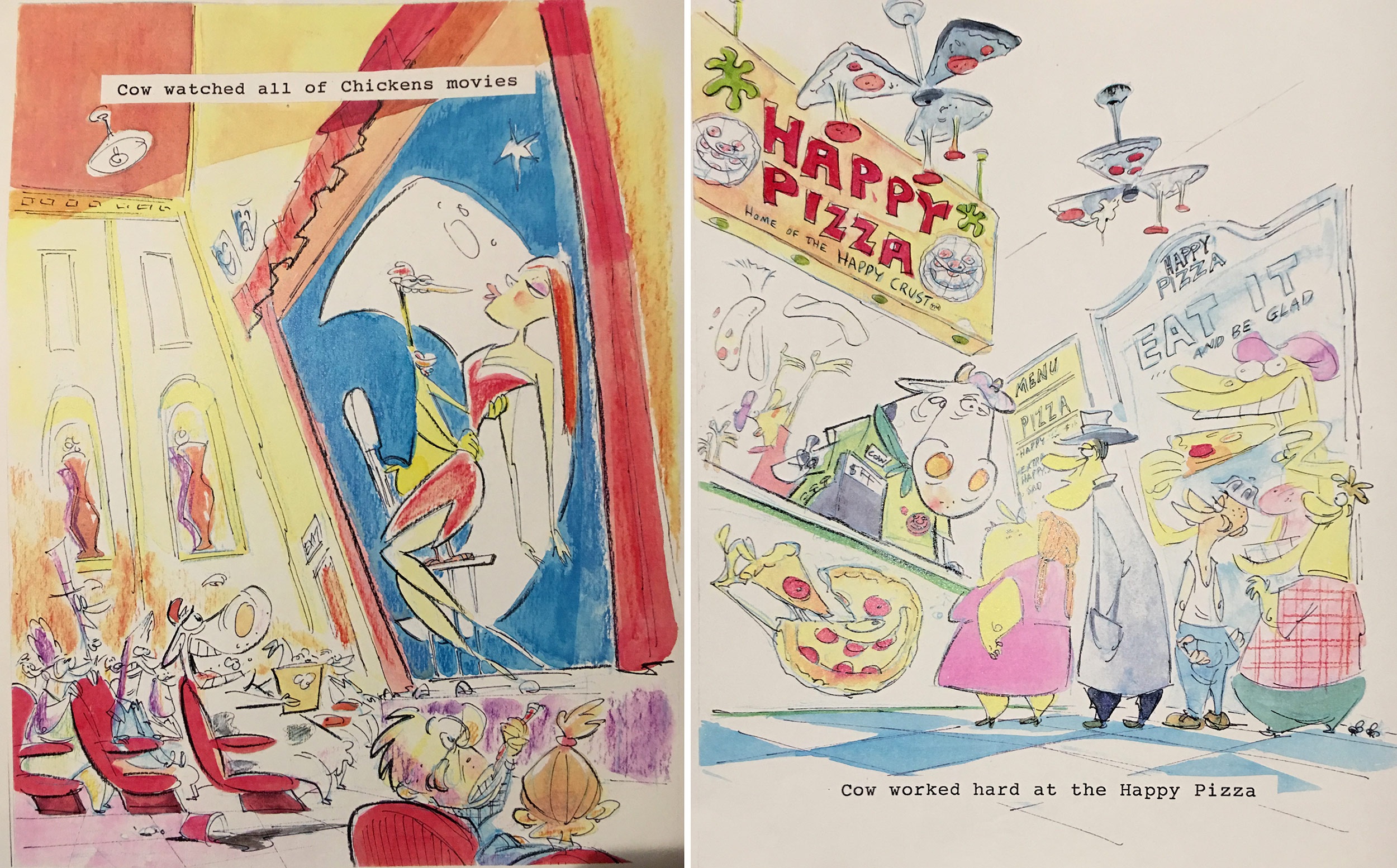
Have you ever heard the show in other languages?
Feiss: I’ve heard it in Spanish and French and I remember with the pilot, they sent me a video cassette of the show in Mandarin. I was in Europe a few years ago and I ran into somebody who was the voice of the Red Guy in a country from the former Yugoslavia, I think it was Croatia. Sometimes I’ll meet these actors who tell me, ‘I dubbed that voice.’ When I was in Chile, I met the guy who had done one of the voices as well.
For something that began as a bedtime story, it’s had an incredible run.
Feiss: It’s not lost on me, and I’m honored. It’s awesome that it does still play around the world.

.png)